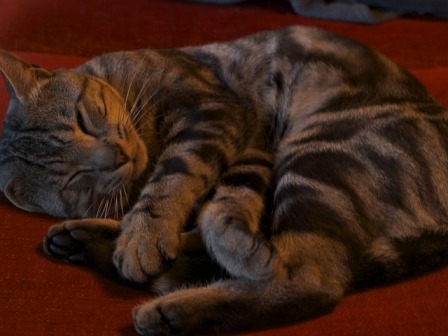Interesting Facts About the Sokoke Cats
Interesting Facts About the Sokoke Cats
The Sokoke cats belong to a small group of cats that are considered as the branch of the Asian Cat Breed Group. They had lived in the rainforest of Kenya and had not mixed with other domestic cats. What is more interesting for this breed is their exclusively natural origin. Because the rainforest was their natural habitat, they had been accustomed to the water long ago. They are one of the few breeds that are not terrified of water. The Sokoke cats have an elegant and muscular body with long extremities. They are especially known for long back legs that give them the ability to jump and run like cheetahs. The Sokoke cats are famous by their unique fur that has almost artistic print, resembling tree bark by its shape. The print is treated like their trademark. The color of their coat varies from light to dark brown, and the hair is pretty short. Their coat has a strong texture but has no undercoat. To understand the specifics of this rare breed, the article ” The Sokoke: Cat Breed FAQ” gives us interesting facts about their history.
Interesting Facts About the Sokoke Cats
The Sokoke was accepted by FIFe in 1993, as the second breed being accepted by FIFe before the recognition by other cat organizations. There is now two forest cats, the Norwegian and the Afro-Danish Sokoke making their mark on the world of cats. It originates from the Sokoke Arabuke forest on the Kenyan coast, one of the few remaining but rapidly dimishing, rainforests in East Africa.
Historically, we can only find one reference to the Sokoke Forest Cat. This is in the Giriama tribal name for cat “Kadzonzo”. The Giriama tribe have lived traditionally around the forest for hundreds of years. All the tribal elders we have known can describe the best of the Sokoke cats perfectly and can differentiate from the three wild genera, as well as the domestic breeds. This is proof of the cats’ very close relationship with the old culture. Today’s Giriama tend to be ignorant of the Kadzonzo. I believe this is deliberate and has deep sociological reasons…. the modern Giriama do not wish to associate with the primitive, but fairly recent, survival behaviour of the past.
Not much was known about the Sokoke cat before the Kenyan farmer Jeni Slater in 1978 found a litter of kittens in her coconut plantation. Jeni Slater is an experienced horsebreeder and found the kittens so special that she brought them home as pets. Their pattern “blotched tabby” does not exist in East Africa, and their body type is described as “foreign” (tall and slender) whereas the Kenyan housecats are of the “cobby” type and with a much thicker coat.
The second piece of good luck for the survival of the Sokoke Cat was that Gloria Moeldrup was a fishing client of the Slaters, Jeni invited Gloria to see the cats, and she also like Jeni recognized a unique makeup, pattern and behaviour of the cat. In 1984 Jeni expressed fear that the breed might not survive in Kenya due to many administrative difficulties. Gloria Moeldrup then decided to move a breeding pair to Denmark, where in 1984, Sokoke cats where shown for the first time in Copenhagen and in 1985 “Jenny” and “Mzuri” had their first litter.
From then on came the long journey to recognition, in 1990 Gloria Moeldrup imported three more cats from Watamu to strengthen the breeding stock. The aim to start with was to breed enough cats to keep the breed alive and healthy.
Then in November 1992 the judges committee of FIFe looked at nineteen Sokoke Cats representing five generations. There are now (1997) about 20 breeding Sokoke cats in Denmark, one cat in Italy and three in Holland.
Even though the Sokoke cats have wild roots, they are very affectionate cats with developed social skills. They easily adjust to the noisy environment, full of kids and other pets. The Sokoke is gentle cats, good at making a strong bond with humans. However, they are not clingy cats; they are quite the opposite. Namely, the Sokoke cats are well known for their independent nature. These cats are ideal for families with strong dynamic and schoolchildren. The Sokoke is very active – they jump, run, spring, and tip over all the time and talk loudly to other family members. Even though their level of activities is too high, they are not aggressive. The Sokoke show as sensitive cats that can pick up the mood of their owners. This rare cat is perfect for all people who prefer dynamic and active lifestyle. They are lively pets, responsible for a good atmosphere.










